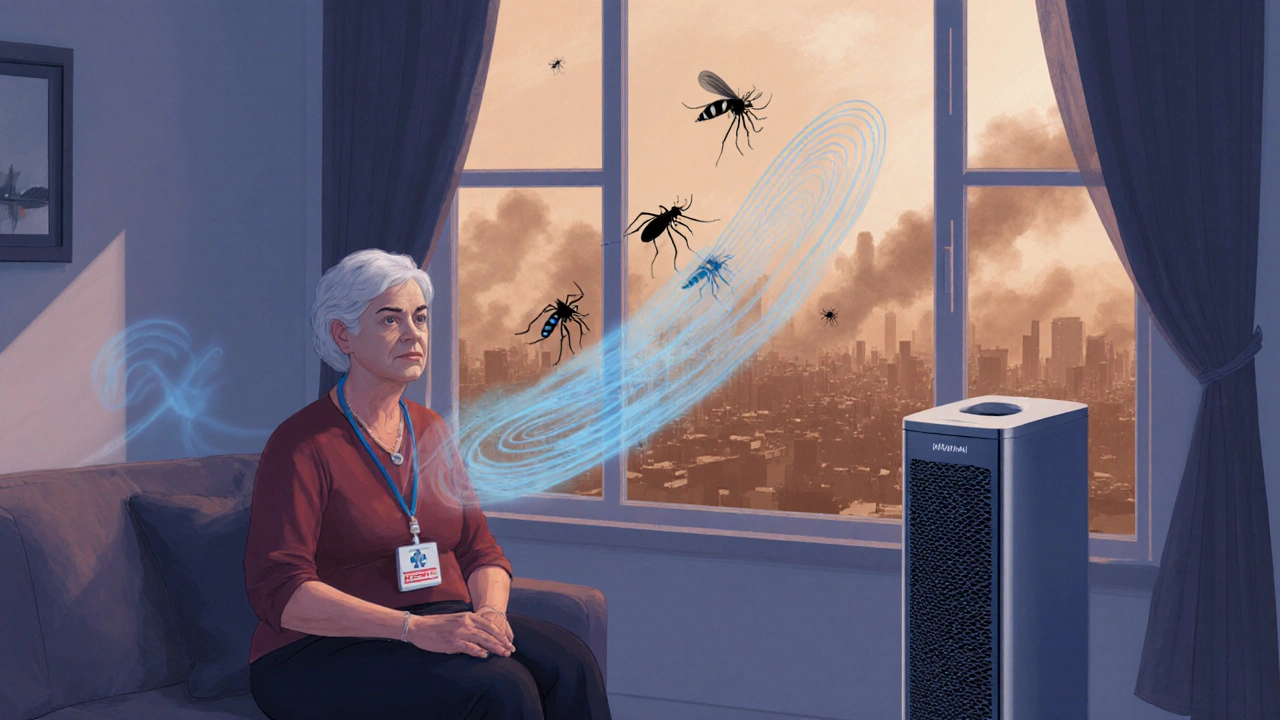Climate Impact Risk Calculator for Immunodeficiency Patients
Key Takeaways
- Rising temperatures and extreme weather directly worsen heat‑related stress for immunodeficient individuals.
- Air‑borne pollutants increase the frequency and severity of respiratory infections in this vulnerable group.
- Changing habitats expand the range of vector‑borne diseases, putting patients at risk of infections they may never have encountered before.
- Vaccination response and drug efficacy can shift as pathogens evolve under climate pressure.
- Proactive steps-temperature‑controlled environments, air filtration, tele‑health monitoring, and updated vaccination schedules-can mitigate many of these risks.
What Is Immunodeficiency?
Immunodeficiency describes a condition where the body's defense system cannot fight infections as effectively as it should. It comes in two main flavors:
Primary immunodeficiency disorders are genetic or congenital defects that impair immune function from birth. Common examples include severe combined immunodeficiency (SCID) and X‑linked agammaglobulinemia.
Secondary immunodeficiency arises because of external factors such as chemotherapy, HIV infection, or long‑term steroid use. Unlike primary forms, it can sometimes be reversed if the underlying cause is treated.
Both types share a heightened susceptibility to bacterial, viral, and fungal invaders, but the ways climate change amplifies those threats differ slightly, as we’ll see.
Defining Climate Change
Climate change refers to the long‑term shift in temperature, precipitation, and wind patterns caused largely by human‑driven greenhouse‑gas emissions. The Intergovernmental Panel on Climate Change (IPCC) reports that global average temperatures have already risen about 1.2°C since pre‑industrial times, and extreme weather events are becoming the new normal.
These environmental shifts are not abstract; they impact everyday health, especially for people whose immune systems are already compromised.
Heat Stress: A Hidden Threat
When outdoor temperatures climb above comfort zones, the body activates cooling mechanisms-sweating, increased heart rate, and vasodilation. For a healthy person, these responses keep core temperature stable. Immunodeficient patients, however, often have reduced heat tolerance because many underlying conditions or medications affect circulation and hydration.
Heat stress can:
- Raise body temperature, creating an environment where viruses replicate faster.
- Impair white‑blood‑cell function, lowering the ability to clear infections.
- Exacerbate dehydration, which reduces mucosal barriers in the lungs and gut.
Studies from the 2023 National Institute of Health (NIH) cohort showed a 27% spike in hospital admissions for opportunistic infections during heat waves among patients with primary immunodeficiency. The same data indicated a 19% rise for those on immunosuppressive therapy.

Air Pollution and Respiratory Risks
Air quality has deteriorated in many megacities as climate‑related stagnation traps pollutants near the ground. Particulate matter (PM2.5) and ozone are especially harmful.
Air pollution is linked to increased rates of bronchitis, pneumonia, and chronic obstructive pulmonary disease (COPD). For immunodeficient patients, even a mild respiratory irritation can turn into a severe infection.
A 2024 European Respiratory Journal analysis found that for every 10µg/m³ rise in PM2.5, the risk of hospitalization for fungal lung infections grew by 8% in secondary immunodeficiency groups.
Shifting Vectors: New Pathogen Hotspots
Warmer climates allow disease‑carrying insects-mosquitoes, ticks, sandflies-to move northward. This expands the geographic footprint of illnesses such as dengue, Zika, Lyme disease, and West Nile virus.
Immunodeficient individuals are less able to clear these infections, leading to chronic or disseminated disease. For example, a 2022 case series from the Mayo Clinic reported three patients with common variable immunodeficiency who developed severe, prolonged dengue fever after an unexpected summer outbreak in Minnesota.
Vaccination Efficacy Under Climate Pressure
Vaccines remain the most effective shield against preventable infections, but their performance can be temperature‑sensitive. Cold‑chain disruptions caused by extreme weather have led to documented losses of vaccine potency.
Moreover, some research suggests that the immune response to vaccination wanes when the body is under chronic heat stress. A 2021 trial on influenza vaccination in patients with secondary immunodeficiency showed a 12% lower seroconversion rate during a prolonged heat wave compared with a normal‑temperature period.
Clinicians should therefore consider:
- Verifying cold‑chain integrity before administration.
- Scheduling vaccinations during cooler months when possible.
- Monitoring antibody titers more closely after each dose.
Medication Interactions and Antimicrobial Resistance
Climate change also fuels antimicrobial resistance (AMR). Warmer waters accelerate bacterial replication, and increased use of antibiotics for climate‑related infections adds selection pressure.
For immunodeficient patients who already rely on prophylactic antibiotics, AMR can render standard regimens ineffective. The CDC’s 2023 AMR report highlighted a 15% rise in multidrug‑resistant Pseudomonas infections among patients receiving long‑term prophylaxis in high‑temperature regions.
Practical steps include rotating prophylactic agents under physician guidance and using susceptibility testing whenever a new infection emerges.

Practical Strategies for Patients and Caregivers
While the macro‑trends sound daunting, there are concrete actions that can lessen the impact.
- Control indoor climate: Use air‑conditioning or portable coolers; maintain indoor temperatures between 68‑72°F (20‑22°C). Install humidity sensors to keep levels under 60%.
- Improve air quality: Deploy HEPA filters; choose low‑VOC paints and furnishings; monitor local AQI (Air Quality Index) and limit outdoor exposure on high‑pollution days.
- Stay hydrated: Aim for at least 2L of fluid daily; electrolytes are essential during heat spikes.
- Use protective clothing: Lightweight, breathable fabrics with UV protection reduce skin‑related infections and sun‑burn risk.
- Leverage telemedicine: Schedule virtual check‑ins during extreme weather to avoid travel‑related exposure.
- Update vaccination schedule: Discuss timing with your immunologist; consider high‑dose or adjuvanted vaccines when appropriate.
- Monitor local disease alerts: Subscribe to public‑health bulletins for emerging vector‑borne threats in your area.
Each of these measures can be tailored to primary or secondary immunodeficiency, but the underlying principle is the same: reduce environmental stressors whenever possible.
Comparing Climate Impacts on Primary vs. Secondary Immunodeficiency
| Impact Area | Primary Immunodeficiency | Secondary Immunodeficiency |
|---|---|---|
| Heat‑related infection risk | Higher - genetic defects often affect thermoregulation. | Moderate - medication‑induced heat intolerance. |
| Air‑pollution sensitivity | Elevated - chronic lung inflammation common. | Variable - depends on underlying disease (e.g., COPD). |
| Vector‑borne disease severity | Severe - impaired antibody production. | Severe - immunosuppressive drugs blunt response. |
| Vaccine response | Reduced - often requires booster or high‑dose formulations. | Reduced - may need timing adjustments around therapy. |
| Antimicrobial resistance risk | High - frequent prophylactic use. | High - long‑term antibiotics common. |
Understanding these nuances helps clinicians prescribe personalized mitigation plans.
Looking Ahead: Policy and Community Action
Individual steps matter, but broader change is essential. Public‑health agencies should prioritize:
- Ensuring resilient cold‑chain logistics for vaccines in disaster‑prone regions.
- Funding research on heat‑tolerant formulations of prophylactic antibiotics.
- Expanding air‑quality monitoring in low‑income neighborhoods where many immunodeficient patients live.
- Integrating climate‑risk assessments into routine immunology clinics.
When policy aligns with personal protection, the net burden on immunodeficiency patients can drop dramatically.
Frequently Asked Questions
How does heat affect my immune cells?
High temperatures raise core body heat, which can temporarily suppress the activity of T‑cells and neutrophils. This makes it easier for bacteria and viruses to establish an infection before the immune system catches up.
Should I change my vaccination schedule because of climate change?
Talk to your immunologist. Often, moving the appointment to a cooler month, confirming that the vaccine has stayed within the recommended temperature range, and checking antibody levels after the shot are prudent steps.
What indoor air measures are most effective?
A high‑efficiency particulate air (HEPA) filter that captures particles down to 0.3µm, combined with a regularly maintained HVAC system, reduces both particulate matter and fungal spores. Add a carbon filter to lower ozone and volatile organic compounds.
Can telemedicine replace in‑person visits during extreme weather?
For routine check‑ups, medication reviews, and symptom triage, telehealth works well. However, lab draws, imaging, or physical exams still require a visit, so keep a backup plan for safe travel.
Is there a link between climate‑driven antimicrobial resistance and my prophylactic antibiotics?
Yes. Warmer environments promote faster bacterial growth, which can increase the chance of resistance developing when antibiotics are used repeatedly. Discuss rotation strategies with your doctor and ensure susceptibility testing when new infections appear.









Comments (11)
Karen Ballard
October 8, 2025 AT 19:32 PMGreat breakdown, thanks for the info! 😊
Gina Lola
October 9, 2025 AT 04:08 AMThe thermoregulatory dysregulation and vector‑borne pathogen proliferation outlined here are textbook examples of climate‑mediated immunological stressors.
I appreciate the integration of epidemiological data with actionable mitigation strategies.
This kind of translational insight is exactly what clinicians need to operationalize patient‑centric care.
Renee van Baar
October 9, 2025 AT 12:45 PMYour summary hits the key points without overwhelming the reader, which is essential for patients navigating complex health information.
Keep emphasizing practical steps like indoor climate control and vaccination timing.
Nadia Stallaert
October 9, 2025 AT 21:22 PMHold on-does anyone else see the hidden agenda behind these so‑called 'mitigation strategies'?
The climate narrative is being weaponized to push a pharmaceutical agenda, and the heat stress data are cherry‑picked!
We're told to buy air‑purifiers, yet the same corporations that pollute the air profit from them!
Remember, every 'recommendation' is a data point in a larger control matrix; question the source, question the motive!!!
In the end, resilience is a myth sold to keep us compliant.
Greg RipKid
October 10, 2025 AT 05:58 AMReal‑world data shows a spike in opportunistic infections during heat waves, so staying cool isn’t just comfortable-it’s lifesaving.
Make sure your HVAC filters are replaced regularly.
John Price Hannah
October 10, 2025 AT 14:35 PMEnough with the paranoia-look at the science!
The NIH study cited in the article demonstrates a statistically significant 27 % increase in hospitalizations, not some conspiratorial plot.
While vigilance is healthy, drowning in fear only hampers proactive health measures.
Use the risk calculator, upgrade your home filtration, and keep your immunizations up to date-let evidence, not speculation, drive your decisions.
Echo Rosales
October 10, 2025 AT 23:12 PMOne could argue that focusing on climate distracts from more immediate infection control measures.
Marisa Leighton
October 11, 2025 AT 07:48 AMFirst of all, thank you for putting together such a comprehensive resource-it’s exactly the kind of guide patients with immunodeficiency need.
Your breakdown of heat stress, air quality, and vector‑borne disease makes complex topics accessible.
I especially love the practical checklist at the end; actionable steps are what turn knowledge into protection.
For anyone reading, remember that indoor temperature control is a cornerstone of safe living during heat spikes.
Invest in a programmable thermostat if you can, and set it to keep the environment between 68 and 72 °F.
Don’t forget to stay hydrated-electrolyte‑rich fluids can make a huge difference in how your body tolerates heat.
Air filtration is another game‑changer; a high‑efficiency particulate air (HEPA) filter captures not only dust but also fungal spores.
If you’re on a budget, consider a DIY box fan with a MERV‑13 filter; it’s surprisingly effective.
When pollution levels rise, plan indoor activities and wear a certified N95 mask if you must step outside.
Telemedicine appointments during extreme weather can keep you connected to your healthcare team without the risk of travel.
Vaccination timing is crucial-schedule shots during cooler months when possible, and always verify the cold‑chain integrity.
If you’re on prophylactic antibiotics, discuss rotation strategies with your provider to stay ahead of antimicrobial resistance.
Monitoring local health alerts for emerging vector‑borne diseases can give you a head start on prevention.
Community support matters, too; joining local patient groups can provide real‑time tips on navigating climate‑related challenges.
Lastly, keep an eye on your own symptoms-early detection of infection can dramatically improve outcomes.
You’re not alone in this; the medical community is adapting, and resources like this article are paving the way.
Stay strong, stay informed, and stay safe!
Brennan Keeler
October 11, 2025 AT 16:25 PMLook, the climate crisis hype is just a distraction from real national security threats-our military readiness suffers when we divert funds to endless carbon taxes.
The article’s focus on ‘air‑quality filters’ and ‘vaccination timing’ is irrelevant when the real battle is protecting our borders from invasive species and foreign pathogens.
We need robust domestic production of PPE, not dependence on global supply chains.
Chelsea Hackbarth
October 12, 2025 AT 01:02 AMActually, the data shows that climate‑induced shifts in vector habitats are already affecting domestic disease patterns 🌍.
Investing in local PPE manufacturing is wise, but ignoring air‑quality standards can backfire-clean indoor air is a frontline defense for immunocompromised patients.
Adam Shooter
October 12, 2025 AT 09:38 AMWhile the gratitude expressed is appreciated, a more nuanced critique would consider the limitations of the risk‑score algorithm-its binary weighting oversimplifies multifactorial exposure.
Moreover, the absence of socioeconomic variables skews the applicability of the recommendations across diverse patient populations.
Future iterations should incorporate stratified modeling to enhance precision.